Analys
Market doubting demand but Saudi/Russia are holding a steady course


Brent crude has sold off hard since 28 September. Fear for the health of the global economy and thus oil demand going forward is at the heart of the sell-off. Prior to that, a clarifying message from the Saudi Energy Minister, Prince Abdulaziz bin Salman, at a conference in Calgary on 18 September to a large degree also removed the USD 100/b plus scenario. Speculators had also accumulated significant long positions in oil since a low point in late June. And the last in have probably been hurt in the sell-off and tried to get out. Lastly we have the US oil inventories published on Wednesday this week which were very bearish as they rose almost 5 m b vs an normal draw this time of year of around 2 m b. And specifically gasoline stocks which jumped 6.5 m b to above the 2015-19 level with gasoline refining margins crashing as a result. But amid all this we still have Saudi/Russia which are holding a steady course with cuts and export reductions to end of year with Saudi spicing this up with Official Selling Price of its Extra Light crude to Europe at USD 7.2/b (Premium to Dubai crude) for November which is the highest since 2002. So USD 100/b plus is not in the cards. But neither is USD 50-60-70/b as Saudi his holding a steady course. Our bet is Brent crude averaging USD 85/b in Q4-23 in a balance between what Saudi Arabia wants and needs versus what is a sensible and acceptable level for the global economy.
The December Brent crude oil contract has fallen from an intraday high of USD 95.35/b on 28 September to now USD 83.9/b, a loss of USD 11.4/b. At heart of this decline is concerns for the outlook for the global economy and thus oil demand.
The clear and almost unanimous message from central banks across the board towards the end of September was ”interest rates higher for longer”. Add in flows for US government bonds where China and Japan no longer are big buyers (if at all), the US Fed is a net seller of bonds (QT) rather than a buyer (QE) while the US government is selling more and more bonds. This has driven the US 10yr government bond yield higher and higher to a recent peak of 4.8% which is the highest since 2007. With no relief in sight, this ”interest rate pain” is going to hurt the global economy and thus oil demand. This is probably one key reason/trigger for why oil has sold down so hard recently.
An other reason is probably the message to the market which Saudi Arabia’s energy minister, Prince Abdulaziz bin Salman, delivered to the market at a conference in Calgary on 18 September. He made it very clear that the current cuts were not about driving the oil price to the sky, but rather that it was precautionary versus uncertain demand. Further that if demand indeed turned out to be strong then hallelujah, they would produce more. The oil market has probably been a bit confused on this point with some saying that the aim of Saudi cuts was to drive crude oil above USD 100/b. Such kind of views was pushed aside by the Saudi minister. A sustained move above USD 100/b was very unlikely after the minister’s statements.
Speculators added more than 300 million barrels of net long positions late June. These have probably taken money off the table in the recent sell-off and thus contributed to the sharpness in the sell-off.
Then we have the US oil inventory data this Wednesday which gave a very bearish message to the market. Rather than a seasonal draw of around 2 m b the total US commercial crude and product stocks rose 4.6 m b. With this the US commercial oil stocks are only about 15 m b below the smoothed 2015-19 seasonal average. Gasoline stocks roes 6.5 m b to a level slightly above the 2015-19 average with implied US gasoline demand falling to the lowest level since 2008. The gasoline refining margin, the crack, has now collapsed to less than USD 6/b while it was more than USD 30/b in late August. US inventories of crude and middle distillates are still significantly below normal. In total almost 50 m b below the 2015-19 level. This is an uncomfortable situation ahead of the winter which keeps the market in a partial bullish grip.
A key bullish driver for crude oil has been the stellar overall refining margins. This has give refineries incentive to buy as much crude as they could and convert it to oil products which consumers could consume. Bullish for crude oil demand. A part of this bullishness has dissipated with the collapse of the gasoline crack. The diesel and jet fuel cracks are however still unusually strong at USD 26/b and USD 31/b vs. seasonal norms of around USD 16/b. Strong mid-dist cracks and still low inventories of middle distillates ahead of the winter will induce refineries to keep processing crude and churn out oil products. As such we should expect US gasoline stocks to continue higher. Gasoline cracks could thus drop yet lower from an already very low level.
But amid all this bearishness we still have OPEC+. We still have Saudi/Russia. And they are holding a strong and steady course. They are extending existing cuts and export reductions to the end of the year. They haven’t wavered for a second. Backing up this picture of steadfastness is the fact that Saudi Arabia has lifted its Official Selling Prices (OSPs) for November. By USD 0.5/b to USD 3.4/b for its Extra Light grade to Asia vs. a 10yr average of USD 2.3/b. And to Europe it has lifted it to USD 7.2/b which is the highest since 2002. These are reference prices vs. the Dubai marker. With this Saudi Arabia is saying to the market: ”You are free to buy our crude, but it will cost you”. It is a way of making its supply less available to the market. Making it more expensive.
Yes, Brent crude can of course sell off further and test the USD 80/b line for a little while. But Saudi/Russia are holding a steady course and USD 85/b is a great price. It should be acceptable for a shaky global economy as well as for Saudi/Russia for the time being.
The December Brent crude oil contract has fallen like a rock since its intraday high of USD 95.35/b on 28 Sep. Interest rates ”high for longer” has created deep concerns for oil demand going forward.
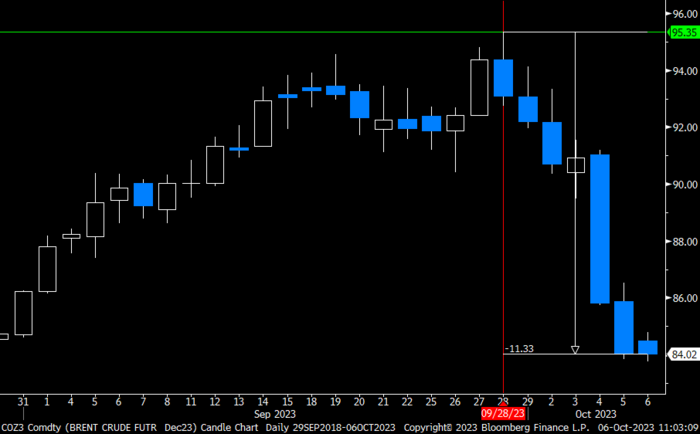
US commercial crude and product stocks are converging to the 2015-19 average and thus easing the bullishness in the market.
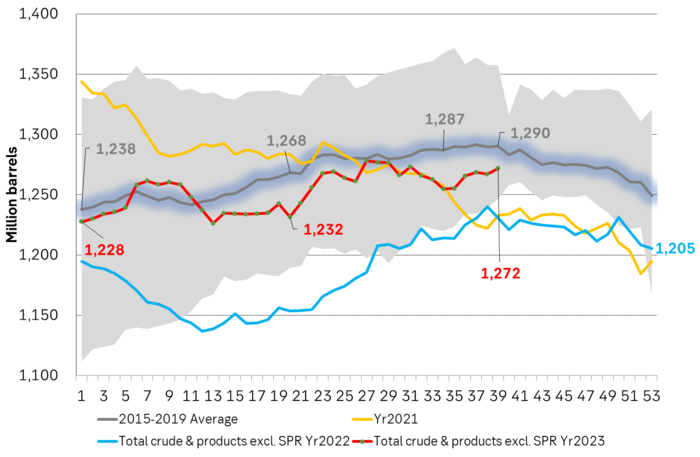
US gasoline stocks were up 6.5 m b last week and are now above the 2015-19 average. They could rise yet higher as implied demand is very weak and refineries keeps producing more gasoline because they are trying to satisfy the market’s craving for middle distillates where stocks are still low.
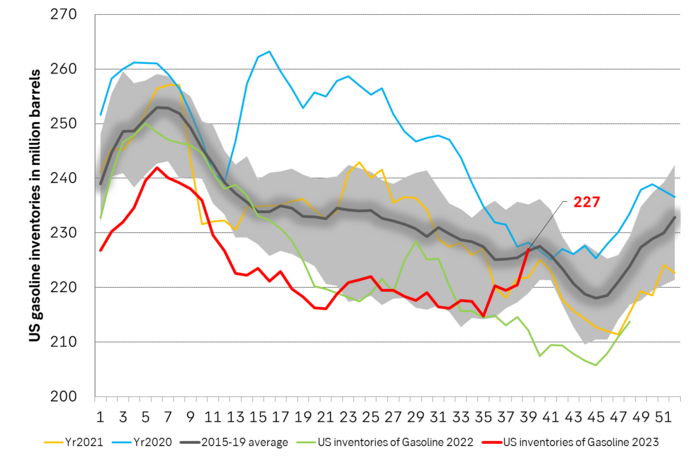
As a result the ARA gasoline crack has crashed to less than USD 6/b and could fall further.
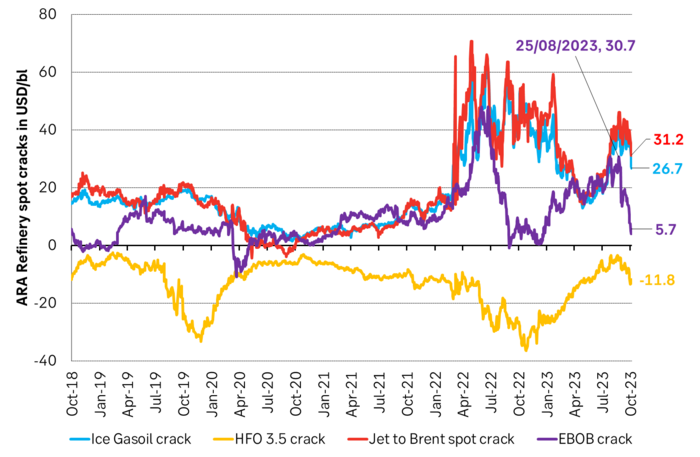
But Saudi Arabia is holding a strong and steady course. It keeps its production at 9 m b/d vs. a normal of 10 m b/d to the end of the year. And to back it up it has lifted its official selling prices further to Asia and to the highest since 2002 to Europe (Extra Light).
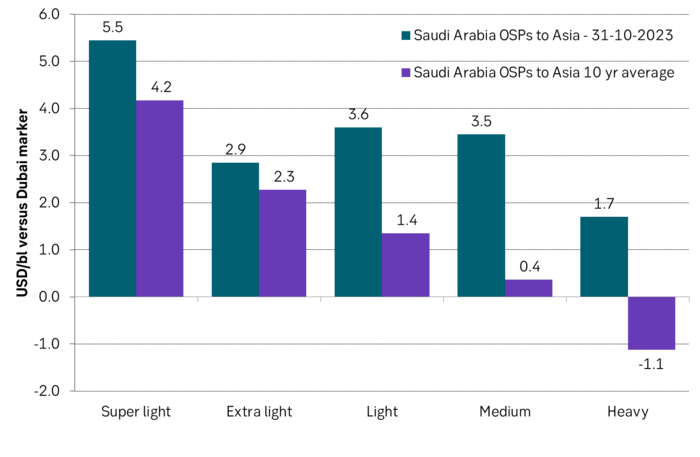
Analys
Tightening fundamentals – bullish inventories from DOE

The latest weekly report from the US DOE showed a substantial drawdown across key petroleum categories, adding more upside potential to the fundamental picture.

Commercial crude inventories (excl. SPR) fell by 5.8 million barrels, bringing total inventories down to 415.1 million barrels. Now sitting 11% below the five-year seasonal norm and placed in the lowest 2015-2022 range (see picture below).
Product inventories also tightened further last week. Gasoline inventories declined by 2.1 million barrels, with reductions seen in both finished gasoline and blending components. Current gasoline levels are about 3% below the five-year average for this time of year.
Among products, the most notable move came in diesel, where inventories dropped by almost 4.1 million barrels, deepening the deficit to around 20% below seasonal norms – continuing to underscore the persistent supply tightness in diesel markets.
The only area of inventory growth was in propane/propylene, which posted a significant 5.1-million-barrel build and now stands 9% above the five-year average.
Total commercial petroleum inventories (crude plus refined products) declined by 4.2 million barrels on the week, reinforcing the overall tightening of US crude and products.


Analys
Bombs to ”ceasefire” in hours – Brent below $70

A classic case of “buy the rumor, sell the news” played out in oil markets, as Brent crude has dropped sharply – down nearly USD 10 per barrel since yesterday evening – following Iran’s retaliatory strike on a U.S. air base in Qatar. The immediate reaction was: “That was it?” The strike followed a carefully calibrated, non-escalatory playbook, avoiding direct threats to energy infrastructure or disruption of shipping through the Strait of Hormuz – thus calming worst-case fears.

After Monday morning’s sharp spike to USD 81.4 per barrel, triggered by the U.S. bombing of Iranian nuclear facilities, oil prices drifted sideways in anticipation of a potential Iranian response. That response came with advance warning and caused limited physical damage. Early this morning, both the U.S. President and Iranian state media announced a ceasefire, effectively placing a lid on the immediate conflict risk – at least for now.
As a result, Brent crude has now fallen by a total of USD 12 from Monday’s peak, currently trading around USD 69 per barrel.
Looking beyond geopolitics, the market will now shift its focus to the upcoming OPEC+ meeting in early July. Saudi Arabia’s decision to increase output earlier this year – despite falling prices – has drawn renewed attention considering recent developments. Some suggest this was a response to U.S. pressure to offset potential Iranian supply losses.
However, consensus is that the move was driven more by internal OPEC+ dynamics. After years of curbing production to support prices, Riyadh had grown frustrated with quota-busting by several members (notably Kazakhstan). With Saudi Arabia cutting up to 2 million barrels per day – roughly 2% of global supply – returns were diminishing, and the risk of losing market share was rising. The production increase is widely seen as an effort to reassert leadership and restore discipline within the group.
That said, the FT recently stated that, the Saudis remain wary of past missteps. In 2018, Riyadh ramped up output at Trump’s request ahead of Iran sanctions, only to see prices collapse when the U.S. granted broad waivers – triggering oversupply. Officials have reportedly made it clear they don’t intend to repeat that mistake.
The recent visit by President Trump to Saudi Arabia, which included agreements on AI, defense, and nuclear cooperation, suggests a broader strategic alignment. This has fueled speculation about a quiet “pump-for-politics” deal behind recent production moves.
Looking ahead, oil prices have now retraced the entire rally sparked by the June 13 Israel–Iran escalation. This retreat provides more political and policy space for both the U.S. and Saudi Arabia. Specifically, it makes it easier for Riyadh to scale back its three recent production hikes of 411,000 barrels each, potentially returning to more moderate increases of 137,000 barrels for August and September.
In short: with no major loss of Iranian supply to the market, OPEC+ – led by Saudi Arabia – no longer needs to compensate for a disruption that hasn’t materialized, especially not to please the U.S. at the cost of its own market strategy. As the Saudis themselves have signaled, they are unlikely to repeat previous mistakes.
Conclusion: With Brent now in the high USD 60s, buying oil looks fundamentally justified. The geopolitical premium has deflated, but tensions between Israel and Iran remain unresolved – and the risk of missteps and renewed escalation still lingers. In fact, even this morning, reports have emerged of renewed missile fire despite the declared “truce.” The path forward may be calmer – but it is far from stable.
Analys
A muted price reaction. Market looks relaxed, but it is still on edge waiting for what Iran will do

Brent crossed the 80-line this morning but quickly fell back assigning limited probability for Iran choosing to close the Strait of Hormuz. Brent traded in a range of USD 70.56 – 79.04/b last week as the market fluctuated between ”Iran wants a deal” and ”US is about to attack Iran”. At the end of the week though, Donald Trump managed to convince markets (and probably also Iran) that he would make a decision within two weeks. I.e. no imminent attack. Previously when when he has talked about ”making a decision within two weeks” he has often ended up doing nothing in the end. The oil market relaxed as a result and the week ended at USD 77.01/b which is just USD 6/b above the year to date average of USD 71/b.

Brent jumped to USD 81.4/b this morning, the highest since mid-January, but then quickly fell back to a current price of USD 78.2/b which is only up 1.5% versus the close on Friday. As such the market is pricing a fairly low probability that Iran will actually close the Strait of Hormuz. Probably because it will hurt Iranian oil exports as well as the global oil market.
It was however all smoke and mirrors. Deception. The US attacked Iran on Saturday. The attack involved 125 warplanes, submarines and surface warships and 14 bunker buster bombs were dropped on Iranian nuclear sites including Fordow, Natanz and Isfahan. In response the Iranian Parliament voted in support of closing the Strait of Hormuz where some 17 mb of crude and products is transported to the global market every day plus significant volumes of LNG. This is however merely an advise to the Supreme leader Ayatollah Ali Khamenei and the Supreme National Security Council which sits with the final and actual decision.
No supply of oil is lost yet. It is about the risk of Iran closing the Strait of Hormuz or not. So far not a single drop of oil supply has been lost to the global market. The price at the moment is all about the assessed risk of loss of supply. Will Iran choose to choke of the Strait of Hormuz or not? That is the big question. It would be painful for US consumers, for Donald Trump’s voter base, for the global economy but also for Iran and its population which relies on oil exports and income from selling oil out of that Strait as well. As such it is not a no-brainer choice for Iran to close the Strait for oil exports. And looking at the il price this morning it is clear that the oil market doesn’t assign a very high probability of it happening. It is however probably well within the capability of Iran to close the Strait off with rockets, mines, air-drones and possibly sea-drones. Just look at how Ukraine has been able to control and damage the Russian Black Sea fleet.
What to do about the highly enriched uranium which has gone missing? While the US and Israel can celebrate their destruction of Iranian nuclear facilities they are also scratching their heads over what to do with the lost Iranian nuclear material. Iran had 408 kg of highly enriched uranium (IAEA). Almost weapons grade. Enough for some 10 nuclear warheads. It seems to have been transported out of Fordow before the attack this weekend.
The market is still on edge. USD 80-something/b seems sensible while we wait. The oil market reaction to this weekend’s events is very muted so far. The market is still on edge awaiting what Iran will do. Because Iran will do something. But what and when? An oil price of 80-something seems like a sensible level until something do happen.
-

 Nyheter3 veckor sedan
Nyheter3 veckor sedanMahvie Minerals växlar spår – satsar fullt ut på guld
-

 Nyheter4 veckor sedan
Nyheter4 veckor sedanUppgången i oljepriset planade ut under helgen
-

 Nyheter4 veckor sedan
Nyheter4 veckor sedanLåga elpriser i sommar – men mellersta Sverige får en ökning
-

 Nyheter3 veckor sedan
Nyheter3 veckor sedanJonas Lindvall är tillbaka med ett nytt oljebolag, Perthro, som ska börsnoteras
-

 Analys3 veckor sedan
Analys3 veckor sedanA muted price reaction. Market looks relaxed, but it is still on edge waiting for what Iran will do
-

 Nyheter3 veckor sedan
Nyheter3 veckor sedanOljan, guldet och marknadens oroande tystnad
-

 Analys4 veckor sedan
Analys4 veckor sedanVery relaxed at USD 75/b. Risk barometer will likely fluctuate to higher levels with Brent into the 80ies or higher coming 2-3 weeks
-

 Nyheter3 veckor sedan
Nyheter3 veckor sedanDomstolen ger klartecken till Lappland Guldprospektering









